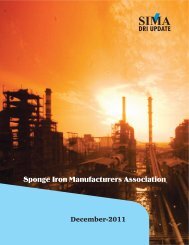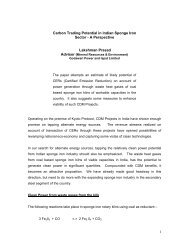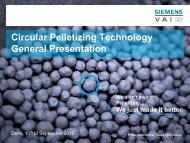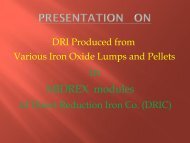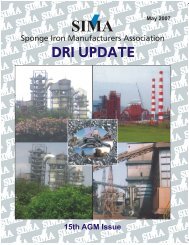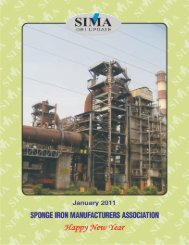Green Steelmaking with the MIDREX and FASTMET Processes
Green Steelmaking with the MIDREX and FASTMET Processes
Green Steelmaking with the MIDREX and FASTMET Processes
You also want an ePaper? Increase the reach of your titles
YUMPU automatically turns print PDFs into web optimized ePapers that Google loves.
Figure 1<br />
Blast Furnace<br />
Source: www.bbc.co.uk<br />
On a macro basis, <strong>the</strong>re are three ways to lower CO 2 emissions from iron <strong>and</strong> steelmaking<br />
production: 1) reduce energy consumption so that less energy (<strong>and</strong> carbon) is required per ton<br />
of steel produced, 2) sequester <strong>the</strong> CO 2 produced underground, ei<strong>the</strong>r in storage or for<br />
enhanced oil recovery, <strong>and</strong> 3) use an energy source <strong>with</strong> less carbon than coal. Option 1) has<br />
been a serious focus for many years. Since 1980, <strong>the</strong> USA steel industry has reduced energy<br />
consumption per ton of steel 45 percent. However, fur<strong>the</strong>r gains are increasingly difficult as<br />
<strong>the</strong> processes become more <strong>and</strong> more efficient. Option 2) is being studied <strong>and</strong> <strong>the</strong>re is<br />
promise, but it does nothing to reduce emissions from <strong>the</strong> iron <strong>and</strong> steelmaking processes, it<br />
just reduces <strong>the</strong> CO 2 emitted to <strong>the</strong> atmosphere. Also, <strong>the</strong>re are significant practical<br />
limitations that must be overcome for this approach to have a major impact. Option 3) may<br />
hold <strong>the</strong> most promise for significantly reducing carbon emissions. An attractive energy<br />
source is natural gas.<br />
Natural gas is primarily methane, <strong>with</strong> a chemical formula of CH 4 . Thus, <strong>the</strong>re are four<br />
hydrogen atoms for each carbon atom. Coal is a diverse mixture of compounds, but it has a<br />
higher proportion of carbon to hydrogen than does natural gas. Since almost all <strong>the</strong> carbon<br />
<strong>and</strong> hydrogen used in an iron <strong>and</strong> steelmaking facility are eventually converted to CO 2 <strong>and</strong><br />
H 2 O (water), natural gas produces much less carbon dioxide than does coal. Table I shows<br />
<strong>the</strong> CO 2 emission rates for combusting methane versus two types of coal.<br />
2 April 15, 2008



